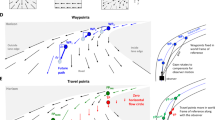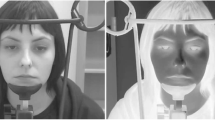Abstract
It is controversial whether head and eye movement information are required to discern locomotor heading from visual motion information1,2,3,4,5. We present a new theory of steering based on active gaze and retinal flow, which demonstrates that future paths could be judged using known properties of visual cortex neurons, without recovering current heading or integrating extra-retinal signals. This theory is consistent with the gaze-sampling behavior promoted in advanced driving instruction.


Similar content being viewed by others
References
Warren, W. H. & Hannon, D. J. Nature 336, 162–163 (1988).
Roydon, C. S., Banks, M. S. & Crowell, J. A. Nature 360, 583–585 (1992).
Royden, C. S. Vision Res. 34, 3215–3222 (1994).
Lappe, M., Bremmer, F. & van den Berg, A. V. Trends Cog. Sci. 3, 329–336 (1999).
Crowell, J. A., Banks, M. S., Shenoy, K. V. & Andersen, R. A. Nat. Neurosci. 1, 732–737 (1999).
Land, M. F. in Vision and Action (eds Harris, L. R. & Jenkins, M.) 163–180 (Cambridge Univ. Press, Cambridge, UK, 1998).
Police Drivers Handbook (HMSO, UK, 1998).
Experienced Rider Course (Motorcycle Safety Foundation, 1992).
Warren, W. H. Nat. Neurosci. 1, 647–649 (1999).
Maunsell, J. H. R. & Van Essen, D. C. J. Neurophysiol. 49, 1127–1147 (1983).
Perrone, J. A. & Stone, L. S. Vision Res. 34, 2917–2938 (1994).
Warren, W. H. et al. Biol. Cybern. 65, 311–320 (1991).
Wann, J. P., Rushton, S. K. & Lee D. N. in Studies in Perception and Action III (eds Bardy, B. G., Bootsma, R. J. & Guiard, Y.) 171–174 (Lawrence Erlbaum, Mahwah, New Jersey, 1995).
Gibson, J. J. Brit. J. Psychol. 49, 182–194 (1958).
Rushton, S. K., Harris, J. M., Lloyd, M. R. & Wann, J. P Curr. Biol. 8, 1191–1194 (1998).
Acknowledgements
This research was supported by UK EPSRC grant GR/L18693 and GR/L16125.
Author information
Authors and Affiliations
Corresponding author
Supplementary information
Rights and permissions
About this article
Cite this article
Wann, J., Swapp, D. Why you should look where you are going. Nat Neurosci 3, 647–648 (2000). https://doi.org/10.1038/76602
Received:
Accepted:
Issue Date:
DOI: https://doi.org/10.1038/76602
- Springer Nature America, Inc.
This article is cited by
-
Theoretical interpretation of drivers’ gaze strategy influenced by optical flow
Scientific Reports (2021)
-
Drivers use active gaze to monitor waypoints during automated driving
Scientific Reports (2021)
-
Dynamic scan paths investigations under manual and highly automated driving
Scientific Reports (2021)
-
Humans use Optokinetic Eye Movements to Track Waypoints for Steering
Scientific Reports (2020)
-
When flow is not enough: evidence from a lane changing task
Psychological Research (2020)





